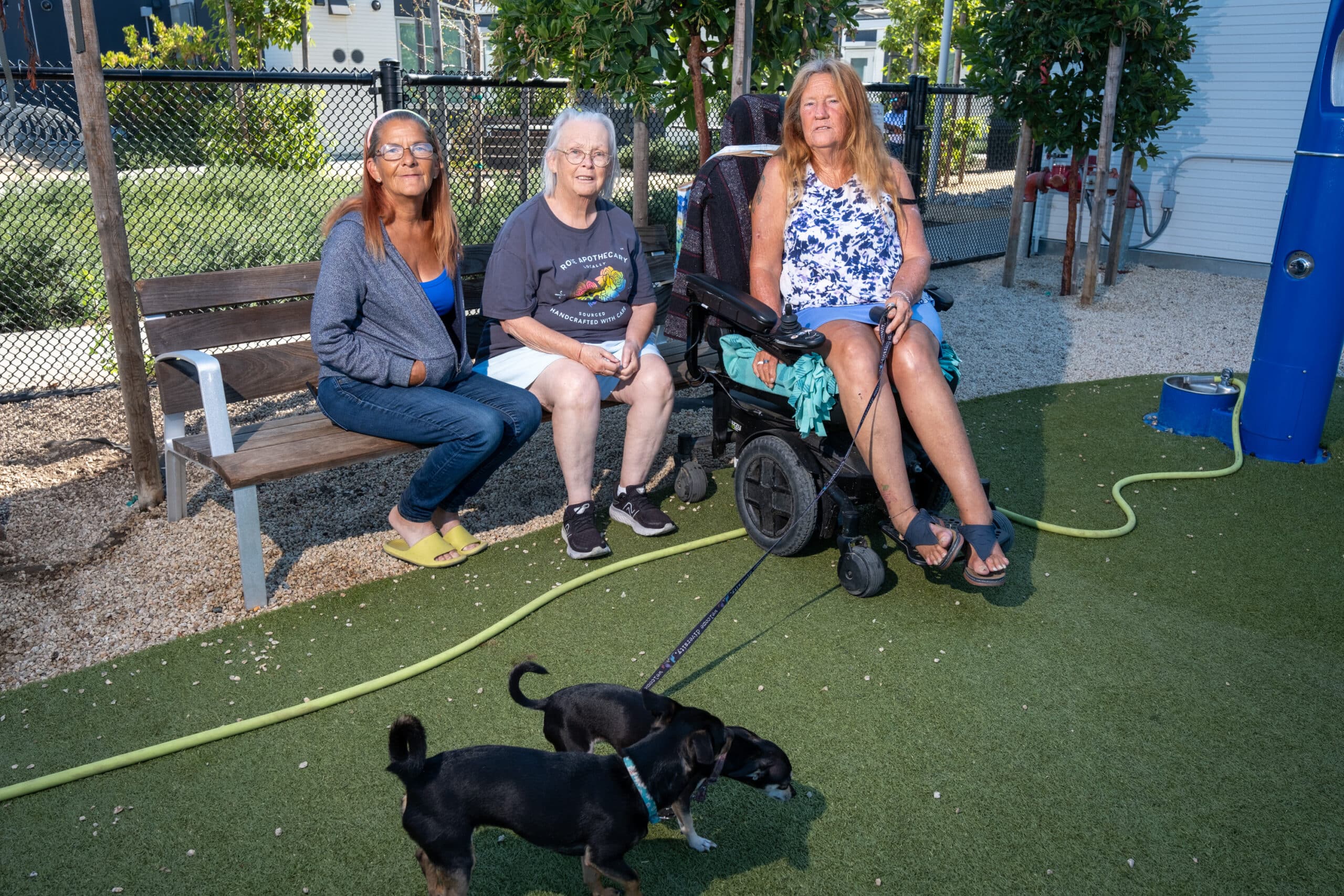Older adults are among the fastest-growing segments of the homeless population; four in 10 slide into homelessness for the first time past the age of 55
Jane Hanna Anderson’s memories of living in Belmont’s Twin Pines Park (“a treasure hidden in the middle of the city”) include serene deer and nights filled with twinkling stars.
“Being in the park was a lot of fun. I just choose to see the positive things instead of the negative things,” Anderson said.
Yet the grind – hot days, cold nights, callous looks, the constant hunt for a meal – took a toll. “My health has really been compromised.”
Anderson is 72 years old.
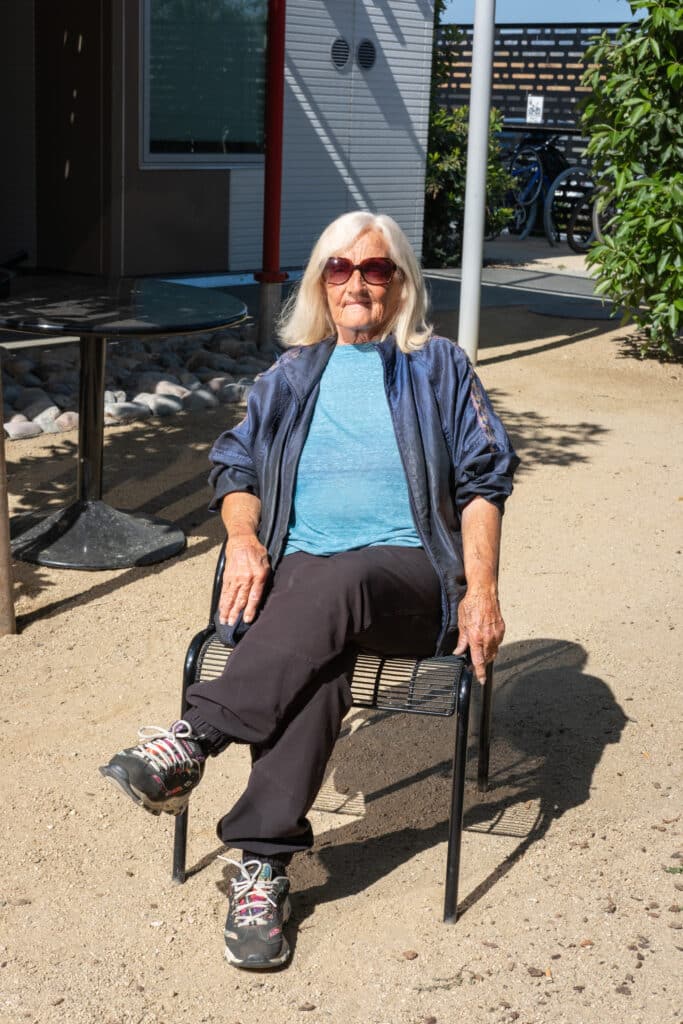
She is among a growing population of older adults who ended up homeless at an age when many contemporaries are enjoying retirement. She now stays at the County’s Navigation Center, which provides a safe and free but temporary home.
With a roof over her head and warm meals in the dining hall, Anderson, who became homeless following the death of her disabled son, can focus on her health. She’s also scheduling a dental implant. “I can’t eat,” she said, “and I used to have a pretty smile.” At the same time, a cadre of case managers and counselors works to find her long-term housing.
Unlike traditional shelters, people with partners, pets and possessions are welcome at the Navigation Center. People can access medical and dental care and mental health and substance use treatment and services, get connected to public benefits and, importantly, feel that they are not alone.
“A lot of us here, we fell through the cracks,” said Paul Slager, 71, who was living outdoors before moving into the Navigation Center. “I don’t know if it was through stupidity, not planning out my old age right. It happened. Here I am.”
Nearly half – 48 percent – of clients enrolled at the Navigation Center are aged 55 or older, according to the latest numbers from LifeMoves, the nonprofit agency that operates the Navigation Center under a County contract.
“This could be your mother, your father, an aunt, an uncle. Our incredibly high housing prices leave so many of our residents a paycheck or an unfortunate series of events away from losing their housing,” said Warren Slocum, president of the San Mateo County Board of Supervisors.
“Everyone deserves to be treated with dignity and respect,” Slocum said. “And that’s our goal by building the Navigation Center, a place where people can have a respite from their circumstances and, with a helping hand, hopefully bounce back.”
In California, older adults are among the fastest-growing segments of the homeless population: nearly half of the single adults living on the streets – 47 percent – are aged 50 or older.
And of those, four in 10 had their first episode of homelessness after age 50, according to a comprehensive study by UCSF’s Benioff Homelessness and Housing Initiative.
Local numbers reflect statewide trends. Of all Navigation Center clients from July 2023 to June 2024 who were homeless for the first time, 41 percent were over the age of 55.
“While there are many barriers our clients who are over the age of 55 years old face, being on a fixed income and not having enough below market rate housing available are the most common,” said Jacob Stone of LifeMoves.
Overall, the proportion of people aged 65 and older experiencing homelessness is expected to triple between 2017 and 2030, according to the UCSF/Benioff report.
With the over-60 population in San Mateo County growing faster than any other age group, more and more older adults will be a single event – a job loss, an injury or illness, a foreclosure or a conflict within a family – from homelessness.
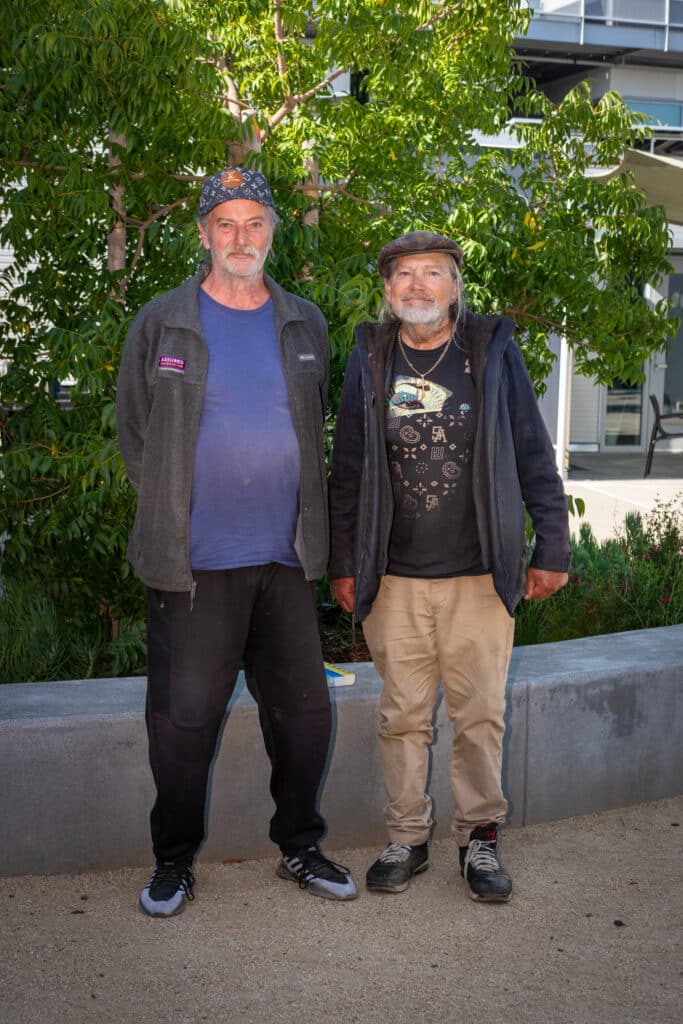
Placing older adults in long-term housing proves challenging in San Mateo County, home to some of the highest rents and housing prices in the nation.
Those aged 55 or older typically spend nearly twice as many days at the Navigation Center (a median of about 160 days) than the client population in general, according to figures provided by LifeMoves.
“We also see a lot of our older clients have a disabling condition and/or are medically fragile that have gone years without seeking proper and consistent medical care,” Stone said. “So, when you start compounding these barriers together, it makes it extremely challenging for these individuals to secure proper housing without support of a housing subsidy or voucher.”
Slager is one of nearly a dozen older clients at the Navigation Center who shared their experiences on a recent sunny afternoon. Two rode to an airy meeting room on wheelchairs, one packing oxygen; some came with the aid of walkers and canes.
A common theme emerged.
Overwhelmingly, these older adults worked a variety of jobs over their lifetimes, rarely able to cobble together significant savings. Then a calamity struck as they got older.
The illness or death of a loved one. Divorce. Getting laid off. Evicted. The onset of a disability that made work all but impossible. Sometimes substance use played a role. Sometimes not.
“My dream in life, and I lived it for the most part, was to be a musician. Rhythm and blues. Rock and roll, of course. But mainly rhythm and blues,” said Slager, a San Francisco native who moved to San Mateo County years ago. “I had to get a real job so I ended up in the shipyards.”
Many clients enter the Navigation Center with income; with the high cost of living in the region, however, that income is not enough to meet basic demands.
He married, had “the American dream.” Then things fell apart. He went from homeowner to renting a room to living by the freeway or in a park trying to find “little safe places.”
“It’s just horrible. I had my stuff stolen six or seven times,” he said. “Guitars. Clothes. Family heirlooms I had my whole life. My mother’s ashes. I think they thought it was drugs. I just happened to have them with me because I couldn’t leave them.”
“I was scared half to death until I came here,” he said. “I feel safe here. I truly feel safe here.”
As Joyce Brown will tell you, “I was born and raised in Redwood City, California. I love it.” She’s 66.
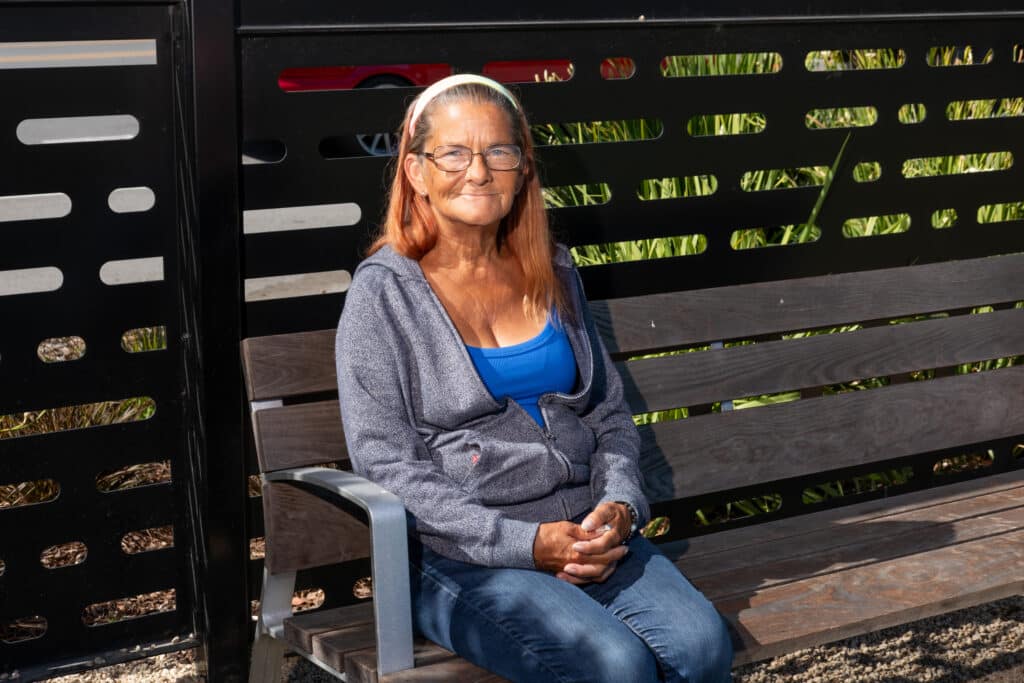
She’s a Sequoia High graduate whom you might have run across at the old Golden West Pancakes or Bob’s Courthouse coffee shop, the latter once a go-to lunch stop for County officials, Sheriff’s deputies and news reporters and a popular family breakfast spot.
“They put all the kids in my station because I could get the kids to eat when the parents couldn’t,” Brown recalled. “I go, ‘I haven’t had my break yet. Can I eat that?’ And all of a sudden, they would start eating.”
To make ends meet, Brown served beers and cocktails at “most of the bars in Redwood City because I held three jobs at one time.” She lost her last job during the COVID-19 pandemic, as did her husband.
Of LifeMoves client respondents from July 2023 to June 2024, the median monthly income of clients when they enter programs is $1,100, which includes clients aged 55 or older. LifeMoves, San Mateo County respondents
They couldn’t afford a rent hike to $1,900 a month for their modest apartment so they “ended up in a van. I did two weeks of that and I couldn’t take it anymore and went to the street people (a LifeMoves outreach team), ‘Please take me somewhere. I can’t take this no more.’ And they brought me straight here.”
The couple has lived at the Navigation Center for a year this month, along with their dogs, Sugar and Coco. “I have an application in for housing,” she said. “I haven’t heard anything.”
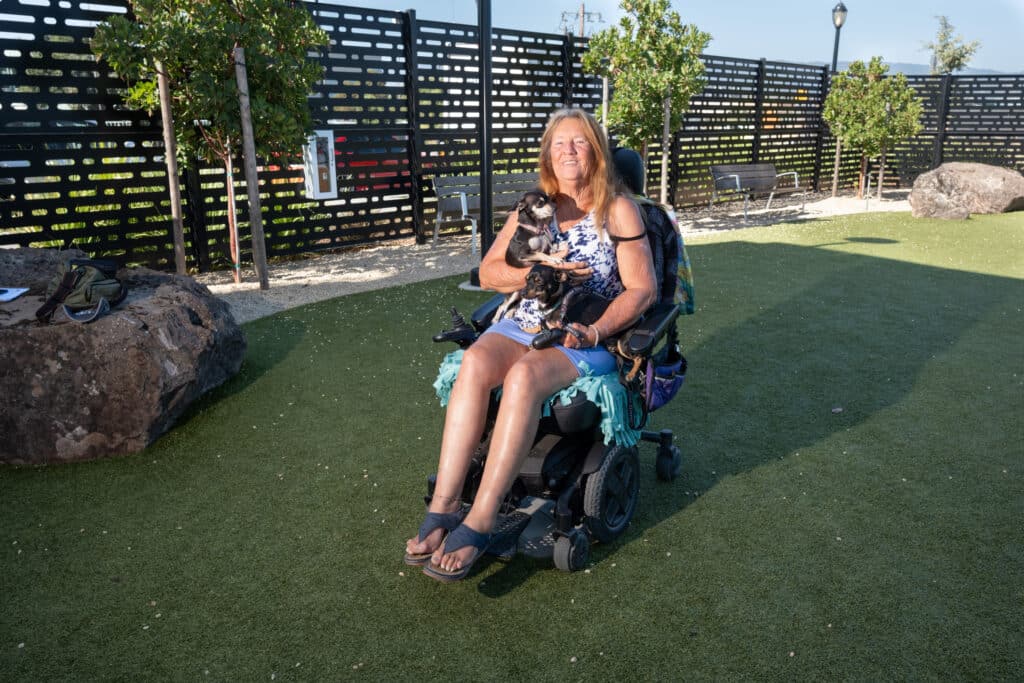
At the Navigation Center, Brown has made friends with Barbara McFarland, a 63-year-old who uses a power wheelchair to get around. McFarland raised a family and spent 42 years working in the health care field, mostly as a certified nursing assistant.
Within the space of a few years, McFarland became disabled due to arthritis in both hips and other joints, lost her job, cared for an uncle, lost her apartment and ended up living in her car behind IHOP in Redwood City, where a LifeMoves outreach team found her and moved her to two shelters before she arrived at the Navigation Center.
When she can, McFarland helps set up for evening meals and cleans up. “I’ve recently had my knee replaced and it didn’t go well. I can’t walk anymore but I still try. I try to help a lot of people, all I can, around here.” Brown hands her a tissue, to dry her tears.
Someone says, “You do. You take care of us.”
McFarland continues, “I’m looking forward to my future. I got two little dogs (Pebbles and Precious) I take care of all the time. I do the best I can.”
Most older homeless adults (86 percent) identify housing costs as a barrier to exiting homelessness. Source: Toward Dignity: Understanding Older Adult Homelessness
David Stedman arrived at the Navigation Center shortly after it opened.
“I did all kinds of stuff – warehouse, painting contractor. My last job was at Stanford as a gardener slash groundskeeper. I did that for five years until my mother had memory loss and I couldn’t leave her alone,” he said. “She’d be out in her bathrobe and slippers hitching a ride to San Francisco where she thought she still lived.”
He had married twice, “always had a home…. It’s not fun. Not having a base. This is transitional and I understand that. But not having a base of your own, that’s been the hardest part for me.”
“I hope to get help so I can get a place. I only take in a little over $1,100 a month in Social Security and I’m going to be 75 in a few weeks.” He pauses. “It is what it is.”
Richard Stamper, a 67-year-old who grew up in Menlo Park and graduated from San Carlos High, knows the date he became homeless: Dec. 8. 2022. “I ran out of money.”
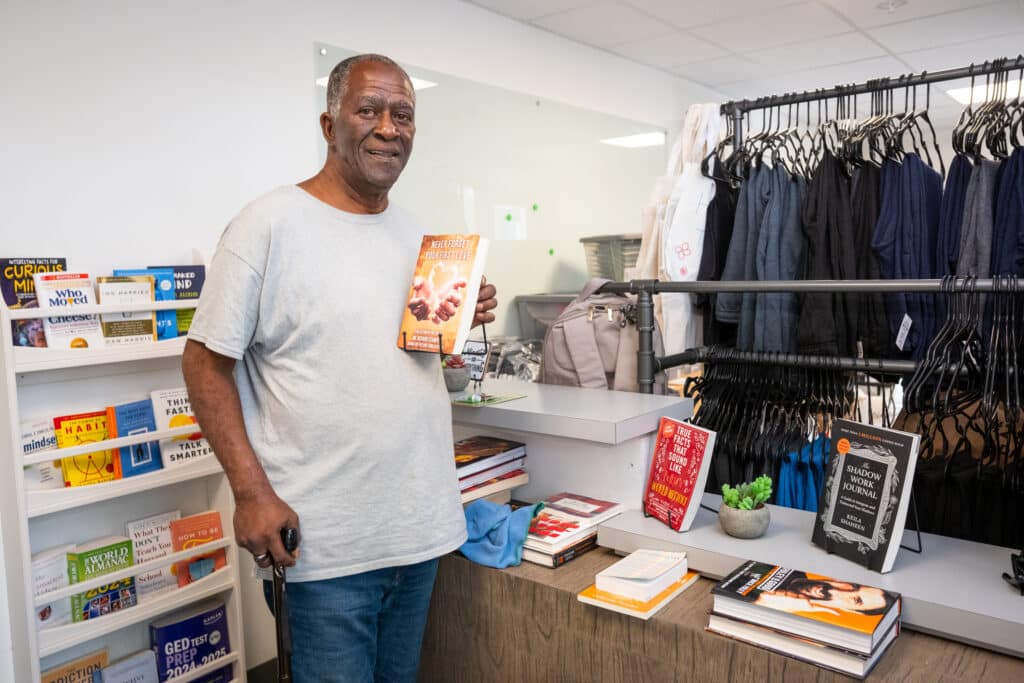
Stamper has captured his philosophy of life in his book of poetry, “Never Forget Your First Love.”
“It’s getting five-star reviews.” (Indeed. In 49 customer ratings on Amazon, it has 4.8 stars out of 5.)
“Experience is the best teacher; we all have a lesson we must Learn,” he writes. “You and I are the future, let’s do our best to Keep Hope Alive.”
Lua Vaiola, 65, and Oli Vaiola, 73, lost their home in Menlo Park. Their hope for the future is “to be stress free as much as possible,” they said through a Tongan interpreter.
Toni Brown, 66, and her husband moved into their car when the hotel she was working at closed. He had also lost his job. Both are facing health challenges. “It’s just been a strange road. But I can see the light at the end of the tunnel. We are here for a reason,” she said.
The death of a son steered Jane Hanna Anderson on the path that led her to sleeping under the stars in Twin Pines Park.
“He lived to be 27 and I took care of him. He was the happiest little boy. He did everything the doctors told me he would never do. I taught him sign language. He was just a very happy little boy,” she recalled.
Income she earned as an in-home support worker ended with his death, although she was still caring for a second son. Together, they lived in a car for two years, until it was towed, and then found themselves under the stars in Belmont.
While she is pulling things together at the Navigation Center (after a lifetime as a caregiver and also other jobs that included being a flight attendant, her monthly Social Security check amounts to $1,006), her son is living in a van.
“I’m always seriously thinking about going back to work in special education because my son trained me so well. I really enjoy the kids and the adults that get overlooked or maybe no one pays attention to,” she said.
“Because of (my son), I learned how to comfort them. They comfort me, I comfort them. I talk with them, even the kids that couldn’t talk. I know I don’t have a whole lot of years left but what I do have left I would really like to do that.”
This is one in a series that explores the County’s efforts to support residents experiencing homelessness. Read more about the County’s Functional Zero goals to provide temporary housing, placement services and other supports to residents in need. Read more
Older Adults and Homelessness
► People identifying as Black and Indigenous are over-represented among people experiencing homelessness. This overrepresentation stems from current and historic policies with racially discriminatory and exclusionary impacts in housing and economic security. Source: Toward Dignity: Understanding Older Adult Homelessness
► Most older adults remained optimistic that financial interventions, such as a shallow subsidy, one-time lump sum payment, or Housing Choice Voucher, could end their homelessness (82%, 95%, and 95%, respectively). Source: Toward Dignity: Understanding Older Adult Homelessness
► With many older adults priced out of affordable housing, the County supports creating more affordable housing, including subsidized units and ones with supportive services for people who need them. One example is Shores Landing, a former hotel converted into 95 units of housing for adults aged 62 and above located in the Redwood Shores neighborhood of Redwood City.

